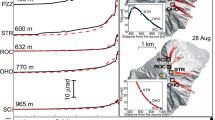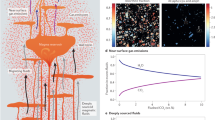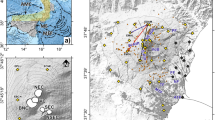Abstract
Magma flow during volcanic eruptions causes surface deformation that can be used to constrain the location, geometry and internal pressure evolution of the underlying magmatic source1. The height of the volcanic plumes during explosive eruptions also varies with magma flow rate, in a nonlinear way2,3. In May 2011, an explosive eruption at Grímsvötn Volcano, Iceland, erupted about 0.27 km3 dense-rock equivalent of basaltic magma in an eruption plume that was about 20 km high. Here we use Global Positioning System (GPS) and tilt data, measured before and during the eruption at Grímsvötn Volcano, to show that the rate of pressure change in an underlying magma chamber correlates with the height of the volcanic plume over the course of the eruption. We interpret ground deformation of the volcano, measured by geodesy, to result from a pressure drop within a magma chamber at about 1.7 km depth. We estimate the rate of magma discharge and the associated evolution of the plume height by differentiating the co-eruptive pressure drop with time. The time from the initiation of the pressure drop to the onset of the eruption was about 60 min, with about 25% of the total pressure change preceding the eruption. Near-real-time geodetic observations can thus be useful for both timely eruption warnings and for constraining the evolution of volcanic plumes.
This is a preview of subscription content, access via your institution
Access options
Subscribe to this journal
Receive 12 print issues and online access
$259.00 per year
only $21.58 per issue
Buy this article
- Purchase on Springer Link
- Instant access to full article PDF
Prices may be subject to local taxes which are calculated during checkout



Similar content being viewed by others
References
Dzurisin, D. Volcano Deformation, Geodetic Monitoring Techniques (Springer, 2007).
Sparks, R. S. J. et al. Volcanic Plumes (Wiley, 1997).
Mastin, L. G. et al. A multidisciplinary effort to assign realistic source parameters to models of volcanic ash-cloud transport and dispersion during eruptions. J. Volcanol. Geotherm. Res. 186, 10–21 (2009).
Björnsson, H. & Guðmundsson, M. T. Variations in the thermal output of the subglacial Grímsvötn Caldera, Iceland. Geophys. Res. Lett. 20, 2127–2130 (1993).
Alfaro, R, Brandsdóttir, B., Rowlands, D. P., White, R. S. & Gudmundsson, M. T. Structure of the Grímsvötn volcano under the Vatnajökull icecap. Geophys. J. Int. 168, 863–876 (2007).
Gudmundsson, M. T. & Milsom, J. Gravity and magnetic studies of the subglacial Grimsvotn volcano, Iceland: Implications for crustal and thermal structure. J. Geophys. Res. 102, 7691–7704 (1997).
Oddsson, B., Gudmundsson, M. T., Larsen, G. & Karlsdóttir, S. Monitoring of the plume from the basaltic phreatomagmatic 2004 Grímsvötn eruption-application of weather radar and comparison with plume models. Bull. Volcanol. 74, 1395–1407 (2012).
Sturkell, E., Einarsson, P., Sigmundsson, F., Hreinsdóttir, S. & Geirsson, H. Deformation of Grímsvötn volcano, Iceland: 1998 eruption and subsequent inflation. Geophys. Res. Lett. 30, 1182 (2003).
Sturkell, E. C. et al. Deformation cycle of the Grímsvötn sub-glacial volcano, Iceland, measured by GPS. Am. Geophys. Fall Meeting abstr. V31H-04 (2012).
Sigmundsson, F. Iceland Geodynamics, Crustal Deformation and Divergent Plate Tectonics (Springer, 2006).
Mogi, K. Relations between the eruptions of various volcanoes and the deformation of the ground surface around them. Bull. Earthq. Res. Inst. Univ. Tokyo 36, 99–134 (1958).
Segall, P. Earthquake and Volcano Deformation (Princeton Univ. Press, 2010).
McTigue, D. F. Elastic stress and deformation near a finite spherical magma body: Resolution of the point source paradox. J. Geophys. Res. 92, 12931–12940 (1987).
Petersen, G. N., Bjornsson, H., Arason, P. & von Löwis, S. Two weather radar time series of the altitude of the volcanic plume during the May 2011 eruption of Grímsvötn, Iceland. Earth Syst. Sci. Data 4, 121–127 (2012).
Gudmundsson, M. T. et al. Ash generation and distribution from the April–May 2010 eruption of Eyjafjallajökull, Iceland. Sci. Rep. 2, 572 (2012).
Sigmundsson, F., Einarsson, P. & Bilham, R. Magma chamber deflation recorded by the Global Positioning System: The Hekla 1991 eruption. Geophys. Res. Lett. 19, 1483–1486 (1992).
Segall, P. Volcano deformation and eruption forecasting. Geol. Soc. Lond. Spec. Publ. 380 (2013).
Mastin, L. G., Roeloffs, E., Beeler, N. M. & Quick, J. E. in A Volcano Rekindled: The Renewed Eruption of Mount St. Helens, 2004–2006: Constraints on the Size, Overpressure, and Volatile Content of the Mount St. Helens Magma System from Geodetic and Dome-growth Measurements During the 2004–2006 + Eruption (eds Sherrod, D. R. et al.) 461–492 (USGS Professional Paper 1750, US Geological Survey, 2008).
Huppert, H. E. & Woods, A. W. The role of volatiles in magma chamber dynamics. Nature 420, 493–495 (2002).
Anderson, K. & Segall, P. Physics-based models of ground deformation and extrusion rate at effusively erupting volcanoes. J. Geophys. Res. 116, B07204 (2011).
Herring, R. T. A., King, W. & McClusky, S. C. GAMIT/GLOBK Reference Manuals, Release 10.4 (MIT Technical Reports, 2010).
Larson, K. M., Bilich, A. & Axelrad, P. Improving the precision of high rate GPS. J. Geophys. Res. 112, B05422 (2007).
Agnew, D. C. & Larson, K. M. Finding the repeat times of the GPS constellation. GPS Sol. 11, 71–76 (2007).
Acknowledgements
We gratefully acknowledge the efforts of volunteers of the Icelandic Glaciological Society who operate the field research station at Mount Grímsfjall on Vatnajökull, and the technicians and staff at our institutions who have been involved in ensuring the successful collection of the data this paper is based on. Support for this work was received from the Icelandic Research Fund, the research fund at University of Iceland, National Science Foundation, USA, the French Polar Institute (IPEV Arctic program 316) and European Community’s FP7 Programme Grant No. 308377 (Project FUTUREVOLC). The mobile X-band radar was on loan from the Italian Civil Protection Agency. We thank UNAVCO for technical support. GMT public domain software was used for some figures. T. Högnadóttir prepared the map on Fig. 1b. R.G. acknowledges support from the Alaska Volcano Observatory.
Author information
Authors and Affiliations
Contributions
S.H. and F.S. coordinated the writing of the paper and the research it is based on; S.H. and R.G. analysed the GPS data; M.J.R., S.H. and F.S. analysed the tilt data; M.T.G., B.O., Á.H., G.L., T.T. and B.A.Ó. measured and evaluated the volume of the eruptive products; H.B. and P.A. measured the plume height from radar data and photos and evaluated variations in eruption rate; M.J.R. analysed the seismic data; S.H., M.J.R., F.S., M.T.G., B.O., P.A. and Á.H. were involved in daily monitoring of the eruptive activity; J.H. was the lead person in engineering and installing the tilt and GPS station at Grímsfjall; H.G., S.H., R.A.B., T.V., E.S., T.Á., B.G.Ó. and T.J. supervised and led the installation and operation of the high-rate GPS stations used in the research; F.S. and T.Á. modelled the geodetic displacements; S.H. produced the paper figures; S.H., R.G., M.J.R. and T.Á. produced Supplementary figures; S.H., F.S., R.G., M.J.R., T. Á. and M.T.G. led the writing of the paper with all authors discussing the results and commenting on the manuscript.
Corresponding authors
Ethics declarations
Competing interests
The authors declare no competing financial interests.
Supplementary information
Supplementary Information
Supplementary Information (PDF 1546 kb)
Rights and permissions
About this article
Cite this article
Hreinsdóttir, S., Sigmundsson, F., Roberts, M. et al. Volcanic plume height correlated with magma-pressure change at Grímsvötn Volcano, Iceland. Nature Geosci 7, 214–218 (2014). https://doi.org/10.1038/ngeo2044
Received:
Accepted:
Published:
Issue Date:
DOI: https://doi.org/10.1038/ngeo2044
This article is cited by
-
Constraints on magma storage conditions based on geodetic volume change and erupted magma volume and application to the 2011 and 2018 eruptions at Kirishima Shinmoe-dake volcano, Japan
Earth, Planets and Space (2023)
-
Quantitative relationship between plume emission and multiple deflations after the 2014 phreatic eruption at Ontake volcano, Japan
Earth, Planets and Space (2019)
-
Synthesis of global satellite observations of magmatic and volcanic deformation: implications for volcano monitoring & the lateral extent of magmatic domains
Journal of Applied Volcanology (2018)
-
Controls on explosive-effusive volcanic eruption styles
Nature Communications (2018)
-
Possible deep connection between volcanic systems evidenced by sequential assimilation of geodetic data
Scientific Reports (2018)



